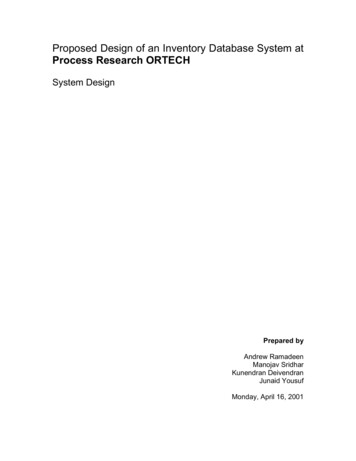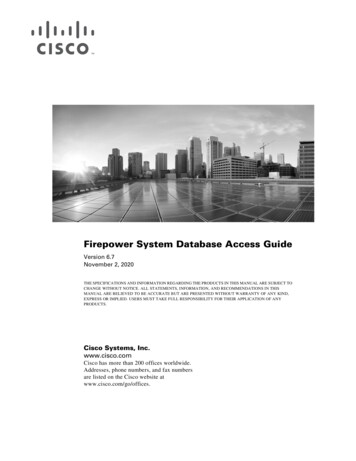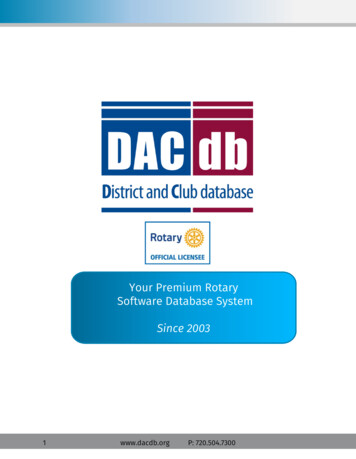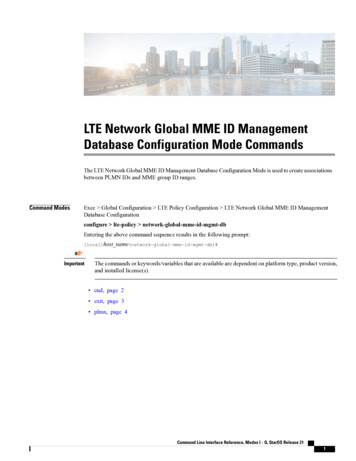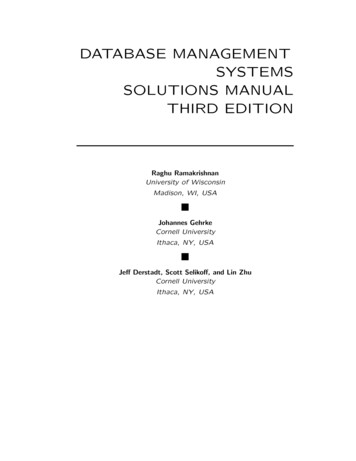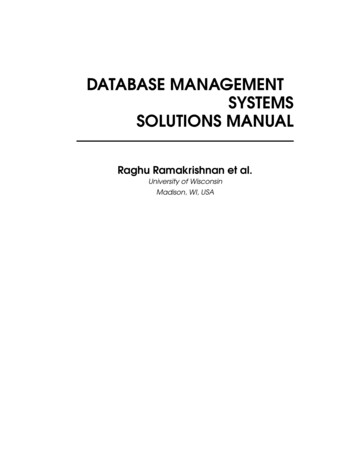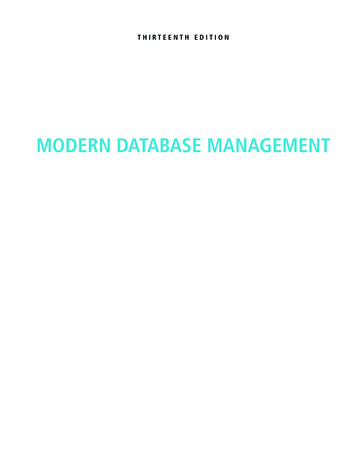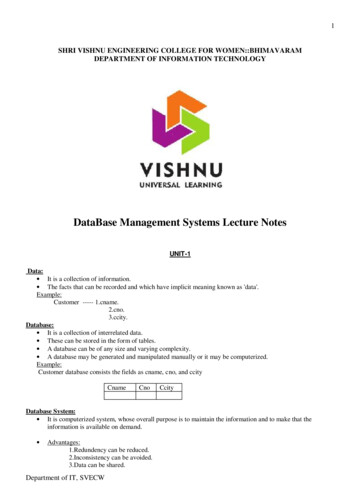![Database Management System [DBMS] Tutorial](/img/2/dbms-tutorial.jpg)
Transcription
Database Management System [DBMS] Tutorial
DATABASE MANAGEMENT SYSTEM [DBMS] TUTORIALSimply Easy Learning by tutorialspoint.comtutorialspoint.comi
ABOUT THE TUTORIALDatabase Management System[DBMS] TutorialDatabase Management System or DBMS in short, refers to the technology of storing and retriving users datawith utmost efficiency along with safety and security features. DBMS allows its users to create their owndatabases which are relevant with the nature of work they want. These databases are highly configurable andoffers bunch of options.This tutorial will teach you basics of Database Management Systems (DBMS) and will also take you throughvarious advance concepts related to Database Management Systems.AudienceThis tutorial has been prepared for the computer science graduates to help them understand the basic toadvanced concepts related to Database Management systems . After completing this tutorial you will findyourself at a moderate level of expertise in DBMS from where you can take yourself to next levels.PrerequisitesBefore you start proceeding with this tutorial, I'm making an assumption that you are already aware aboutbasic computer concepts like what is keyboard, mouse, monitor, input, putput, primary memory and secondarymemory etc. If you are not well aware of these concepts then I will suggest to go through our short tutorial onComputer Fundamentals.TUTORIALS POINTSimply Easy LearningPage 1
Table of ContentDatabase Management System [DBMS] Tutorial . 1Audience . 1Prerequisites . 1DBMS Overview. 7Characteristics . 7Users . 8DBMS Architecture . 93-tier architecture . 9DBMS Data Models . 11Entity-Relationship Model . 11Relational Model . 12DBMS Data Schemas . 13Database schema . 13Database Instance . 14DBMS Data Independence . 15Data Independence: . 15Logical Data Independence . 15Physical Data Independence . 16ER Model : Basic Concepts . 17Entity . 17Attributes. 17Types of attributes: . 17Entity-set and Keys . 18Relationship . 18Relationship Set: . 18Degree of relationship . 18TUTORIALS POINTSimply Easy LearningPage 2
Mapping Cardinalities:. 18ER Diagram Representation . 21Entity . 21Attributes. 21Relationship . 23Binary relationship and cardinality . 23Participation Constraints . 24Generalization Aggregation . 26Generalization . 26Specialization . 26Inheritance . 27Codd's 12 Rules . 28Rule 1: Information rule . 28Rule 2: Guaranteed Access rule . 28Rule 3: Systematic Treatment of NULL values . 28Rule 4: Active online catalog . 28Rule 5: Comprehensive data sub-language rule . 28Rule 6: View updating rule . 28Rule 7: High-level insert, update and delete rule . 29Rule 8: Physical data independence . 29Rule 9: Logical data independence . 29Rule 10: Integrity independence. 29Rule 11: Distribution independence . 29Rule 12: Non-subversion rule . 29Relation Data Model . 30Concepts. 30Constraints . 30Key Constraints:. 30Domain constraints . 31Referential integrity constraints . 31Relational Algebra. 32Relational algebra . 32Select Operation (σ) . 32Project Operation ( ) . 33Union Operation ( ) . 33Set Difference ( ) . 34Cartesian Product (Χ). 34Rename operation ( ρ ) . 34Relational Calculus . 35TUTORIALS POINTSimply Easy LearningPage 3
Tuple relational calculus (TRC) . 35Domain relational calculus (DRC) . 35ER Model to Relational Model . 36Mapping Entity . 36Mapping relationship . 36Mapping Weak Entity Sets . 37Mapping hierarchical entities . 37SQL Overview . 39Data definition Language . 39CREATE . 39DROP . 39ALTER . 40Data Manipulation Language . 40SELECT/FROM/WHERE . 40INSERT INTO/VALUES . 41UPDATE/SET/WHERE . 41DELETE/FROM/WHERE . 41DBMS Normalization . 43Functional Dependency . 43Armstrong's Axioms . 43Trivial Functional Dependency . 43Normalization . 43First Normal Form: . 44Second Normal Form: . 44Third Normal Form: . 45Boyce-Codd Normal Form: . 46DBMS Joins . 47Theta (θ) join . 47Equi-Join . 48Natural Join ( ) . 48Outer Joins . 49Left outer join ( R S ) . 49Right outer join: ( R S ) . 49Full outer join: ( R S) . 50DBMS Storage System . 51Memory Hierarchy . 51Magnetic Disks. 52RAID . 52DBMS File Structure . 55TUTORIALS POINTSimply Easy LearningPage 4
File Organization . 55File Operations. 56DBMS Indexing . 57Dense Index . 57Sparse Index . 58Multilevel Index . 58B Tree. 59Structure of B tree . 59B tree insertion . 59B tree deletion . 60DBMS Hashing . 61Hash Organization . 61Static Hashing . 61Bucket Overflow: . 62Dynamic Hashing . 63Organization . 63Operation . 64DBMS Transaction . 65ACID Properties . 65Serializability . 66States of Transactions: . 67DBMS Concurrency Control . 68Lock based protocols . 68Time stamp based protocols . 70Time-stamp ordering protocol . 70Thomas' Write rule: . 71DBMS Deadlock. 72Deadlock Prevention . 72Wait-Die Scheme: . 72Wound-Wait Scheme: . 72Deadlock Avoidance . 73Wait-for Graph . 73DBMS Data Backup . 74Failure with loss of Non-Volatile storage . 74Database backup & recovery from catastrophic failure . 74Remote Backup . 75DBMS Data Recovery . 76Crash Recovery . 76Failure Classification . 76TUTORIALS POINTSimply Easy LearningPage 5
Transaction failure . 76System crash .
This tutorial has been prepared for the computer science graduates to help them understand the basic to advanced concepts related to Database Management systems . After completing this tutorial you will find yourself at a moderate level of expertise in DBMS from where you can take yourself to next levels. Prerequisites Before you start proceeding with this tutorial, I'm making an assumption .
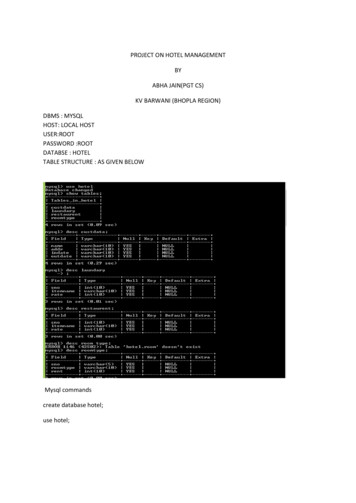
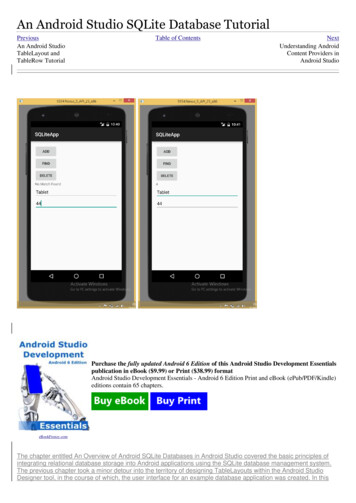
![Unreal Engine 4 Tutorial Blueprint Tutorial [1] Basic .](/img/5/ue4-blueprints-tutorial-2018.jpg)
